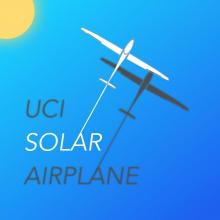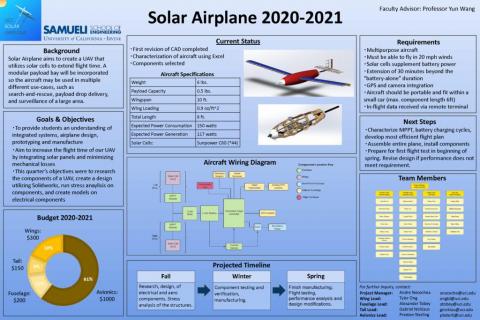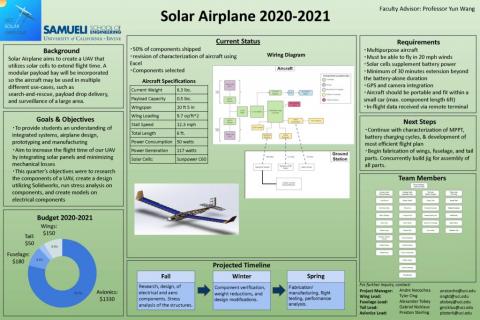UC Irvine Solar Airplane
Background
First, the UC Irvine Solar Airplane was under the Department of Materials Science and Engineering to improve efficiency and miniaturization of solar panels. The project has been handed to the Department of Mechanical and Aerospace Engineering with a new focus. The project aims to optimize a low-cost unmanned aerial vehicle (UAV) for which flight time will be extended, powered by solar panels, by 30 minutes after battery-life.
Design Challenge
The requirements are set by the project manager and advisor:
- Functional airplane (multiple uses).
- Lithium-ion battery.
- Powered by solar panels and battery.
- Extended flying over 30 minutes beyond the battery-alone duration.
- GPS and camera integration.
- The drone should be portable and fit within a standard truck bed used by service workers.
- In-flight data should be given via remote terminal.
Purpose
To assist during natural disasters.
During natural disasters, it can be difficult to gauge the scope of damage. Satellite imagery can be used to help show the extent of damage however this is not always readily available; satellites revisit times are still not fast enough. The imagery the proposed UAV will be able to collect, can be used for evacuation planning, rescue operations and to monitor repairs of areas. A low-cost drone is more accessible by organization while still performing small imaging collection tasks. The proposed drone will be able to fly at low heights to achieve a very low ground sample distance as well. The drone can aid with disaster relief efforts where accessibility is difficult for humans or visibility is limited.
Assumptions:
- The operators of the UAV will be operating remotely and have flying experience.
- The operators will not be required to know any engineering concepts.
- The operators should be able to easily fix parts via manual and template manufacturing methods, such as laser printing, molding, 3D printing and anything with a template.
Goal and Objectives
The UC Irvine Solar Airplane Project Team will seek to design, manufacture, and test a UAV in order to educate its members on the engineering design process in the field of aircraft design and integrated systems design. It will accomplish this by approaching a design challenge, assigned by the acting advisor and reviewed by the project manager, that involves the design, manufacture and testing of an aircraft with integrated solar panels.
- This project aims to extend the flight time of an airplane by mitigating the mechanical and electrical losses and augmenting the battery using solar panels as a proposed solution to the design challenge.
- The plane will be designed and manufactured by the team members to reduce mechanical and physical losses as well as take advantage of the renewable energy source solar panels provide.
- The design should be modular and convenient to assist those in hazardous areas reduce the risk to their lives while still managing to save the lives of others.
- The operation of the design should not require any more training than necessary to fly a standard hobby plane.
- A collection of documents that details the entirety of the engineering process as the team proceeded through it will be collected from each team and compiled into a single organized document to provide context and data for next year's (or later) team.
Team Contacts
Student Contact:
Andre Necochea - anecoche@uci.edu
Faculty Advisor:
Yun Wang - yunw@uci.edu



